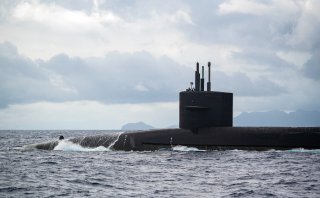USS District of Columbia: The First Nuclear Columbia-Class Submarine Is Named
The delivery of the first Columbia-class boat, the USS District of Columbia, is slated for 2027.
Quietly and secretly patrolling strategically vital areas deep underwater, nuclear-armed submarines make up as much as 70 percent of the U.S. nuclear arsenal. These undersea behemoths are ready to strike at a moment’s notice, completely annihilating any nation or actor willing to attack the United States with nuclear weapons.
The ability to ensure a catastrophic retaliatory nuclear strike in the event of a nuclear attack is intended to generate what could be called a paradoxical mission scope: America’s nuclear submarines are tasked with maintaining an ability to guarantee complete destruction for the purpose of keeping the peace.
The importance given to this strategic deterrence mission explains why the Pentagon has prioritized the acquisition of its now-emerging Columbia-class submarines. Given this, it is no surprise that a recent keel-laying ceremony for the first Columbia-class submarine, to be called the USS District of Columbia, was heavily attended and celebrated by all ranks within the U.S. Navy and the broader collection of military services.
As a replacement for the aging Ohio-class submarines, the new Columbia-class boats are slated to serve well into the 2080s and beyond, a Naval Sea Systems Command report on the ceremony stated.
At a length of 560 feet and displacing 20,810 tons, the Columbia will be the largest submarines ever built by the United States. Its reactor will not require refueling during the lifetime of planned service, making the ship more cost-effective to operate and maximizing its time in deployment, the Navy report said.
“Potential adversaries know the silent service is on patrol at this very moment, but they don’t know where and that protects us all,” Navy Secretary Carlos Del Toro said, according the report. “The venerable Ohio-class that has guarded us for decades is nearing the end of its service life. For the safety of our Sailors, and the security of our world, we must modernize our fleet, and our nuclear command, control, and communications systems.”
Admiral Daryl Caudle, commander of U.S. Fleet Forces Command, said the nuclear-armed submarines are the most “survivable” leg of the undersea triad, suggesting they were indeed much less vulnerable to enemy attack. The reason for this is clear: their ability to clandestinely conduct missions ensures that adversaries have no idea where they are. Thus, U.S. adversaries are assured that they will be completely destroyed in the event they choose to use nuclear weapons against the United States. As for survivability, Caudle is correct. Nuclear-armed aircraft such as a not-so-stealthy B-52 Stratofortress might be both detectable and vulnerable to enemy air defenses. Stealthy, nuclear-capable aircraft such as the B-2 Spirt, B-21 Raider, or F-35A Joint Strike Fighter might fare better, yet they would require some measure of air superiority to deliver nuclear weapons on target from above. Likewise, silos for ground-based intercontinental ballistic missiles (ICBMs) might be seen by an adversary via satellites and therefore be easier to target.
In contrast, nuclear-armed Columbia-class submarines, engineered with paradigm-changing “quieting” technologies, an electric drive, Mk 48 torpedoes, and both low- and high-yield Trident II D5 ballistic missiles, unquestionably enhance its survivability and lethality. The range of the Trident II D5s means the Columbia-class submarines can hold the entire world at risk at any given time, thus greatly reinforcing the U.S. strategic deterrence posture.
The delivery of the first Columbia-class boat, the USS District of Columbia, is slated for 2027. Also, the Navy plans to build only twelve Columbia-class subs, as opposed to the current fleet of fourteen Ohio-class submarines, as the new submarines do not need to be refueled. For this reason, deployments will be more sustainable and steady over time.
Kris Osborn is the Defense Editor for the National Interest. Osborn previously served at the Pentagon as a Highly Qualified Expert with the Office of the Assistant Secretary of the Army—Acquisition, Logistics & Technology. Osborn has also worked as an anchor and on-air military specialist at national TV networks. He has appeared as a guest military expert on Fox News, MSNBC, The Military Channel, and The History Channel. He also has a Master's Degree in Comparative Literature from Columbia University.
Image: Flickr.

